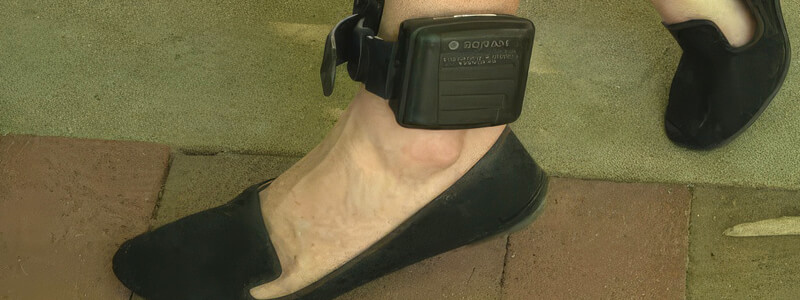SCRAM Ankle Bracelets vs. Jail for DUI
Contents
SCRAM (Secure Continuous Remote Alcohol Monitoring) electronic ankle bracelets have been an effective way to monitor people under house arrest and are now used to measure alcohol consumption by repeat offenders. The Secure Continuous Remote Alcohol Monitor, or SCRAM, reads the blood alcohol content of the person wearing it every 30 minutes and reports those readings to supervising agencies.
An alcohol ankle monitor, or AAM, can help to reduce recidivism and rehabilitate convicted drunk drivers. An AAM is a device commonly used as part of a DWI (Driving While Intoxicated) sentence imposed by the court. It consists of a monitoring bracelet that fits around the ankle and a breathalyzer that alcohol offenders must periodically use when prompted by the monitor. The monitor records a person’s blood alcohol content (BAC) over time, providing the courts with important data about their drinking habits.
The ankle monitor for alcohol is an increasingly popular tool for courts to use to help with alcohol-related cases. Typically, this device is attached to the offender’s ankle, where it can track the level of alcohol in the body.
The SCRAM is not only used by the judicial system but has also been used with some success by alcohol treatment providers to monitor the alcohol consumption of patients.
The purpose of an alcohol ankle monitor is to ensure that convicted drunk drivers adhere to the terms of their sentence and maintain sobriety while on probation. For example, if the court has determined that an offender must remain alcohol-free for 6 months, then the AAM will detect any level of intoxication during that period. This helps to minimize the risk of relapse among those who have been convicted of DWI.
What is SCRAM Ankle Bracelet?
The SCRAM (Secure Continuous Remote Alcohol Monitor) ankle bracelet is a revolutionary technology that helps individuals prone to alcohol abuse stay accountable and sober. This device provides consistent and reliable 24/7 monitoring to ensure an individual comply with any court-ordered sobriety program.
The SCRAM anklet comes equipped with advanced fuel-cell sensors that detect any presence of alcohol in the user’s body, then send out an alert to predetermined contacts, often including probation officers, therapists, or parents. This information can also be monitored in real-time through a secure online portal allowing for transparency throughout the recovery process.
The ankle bracelet is designed to be comfortable and discreet; it is both water-resistant and tamper-evident, so it won’t be affected by everyday activities or attempts to remove or damage it. It also does not require recharging or other tedious maintenance; instead, it simply requires regular inspections by approved personnel to ensure that it is still in proper working order and that the person wearing it is still sober.
The SCRAM ankle bracelet is an innovative device invaluable for anyone looking to maintain sobriety and break free from alcohol addiction. Its reliable tracking and monitoring capabilities make it an ideal solution for individuals and court systems.
The ankle monitor for alcohol operates in a few different ways.
- it uses sensors to detect any alcohol that may be present in the bloodstream.
- it can set up virtual boundaries for the wearer, alerting them if they have strayed too far from home or have entered certain areas where alcohol consumption is prohibited.
- it also records the time of day and location when alcohol is detected and provides data on drinking patterns.
Problems with SCRAM Monitors
In the early years of its use, SCRAM devices had some limitations and problems. Some of these problems included:
- Being too sensitive and giving false positives
- Devices could be removed without providing an alert
- Would not detect some “low-level” drinking events
- Could report false tamper alerts
These problems were noted in a series of studies of the alcohol monitoring devices funded by the National Highway Traffic Safety Administration (NHTSA). The research was conducted by programs monitoring drunk drivers and other alcohol-involved offenders in several states.
One of the problems reported with alcohol monitoring devices was the reluctance of probation officers and caseworkers to participate in the program because they did not believe they would work.
In the New York 8th Judicial District, they found that if they convinced the doubting agents to wear the devices and test them themselves, they soon became advocates for the program.
Different Types of SCRAM Monitors
The device that tests alcohol consumption through the skin (transdermal testing) is called SCRAM CAM (continuous alcohol monitoring). The device is strapped around the offender’s ankle and sends test results to the base unit located in the offender’s home.
Originally, the base unit communicated the test results to the supervising agency through the offender’s telephone landline. Now the base unit can use cell phones or Internet connections.
If the offender is sentenced to home confinement or is given a curfew, the SCRAM CAM can also monitor for compliance. The device eliminates the offender’s ability to miss a test or drink around testing schedules.
SCRAM Remote Breath Tester
A remote handheld device takes a photograph of the person as they blow into the machine and uses facial recognition software to ensure the person taking the test is the person under supervision.
The remote breath tester also contains GPS technology which will record the GPS coordinates of the machine each time it conducts a test. If the offender misses a scheduled test, the machine records the GPS location at the time of the missed test.
SCRAM Can Lower Recidivism Rates
Another NHTSA-funded study looked at the use of SCRAM and recidivism among drunk-driving offenders and concluded that the device effectively monitored alcohol abstinence. It found that the device could reduce the need for probation or other court officers to do in-home monitoring, leading to reduced costs.
The study also reported that offenders who remained abstinent while going through alcohol treatment programs had better outcomes compared to those who were not monitored and not abstinent.
Generally, ankle monitors for alcohol are seen as a more humane way of keeping offenders in check, as they allow them to retain their freedom without serving a jail sentence. However, there are drawbacks to this method of monitoring as well. For example, these monitors require frequent battery replacements and cost a lot of money. Furthermore, wearing an ankle monitor can also be uncomfortable and embarrassing for some people.
Using an alcohol ankle monitor can help individuals establish better drinking habits and aid in rehabilitation. By seeing firsthand how drinking affects them, users can track their BAC levels in real-time and identify patterns that may lead to dangerous behaviors. Through this personalized feedback, they can gain insight into their own drinking behavior and take steps toward establishing healthier habits.
Ultimately, an alcohol ankle monitor is useful for deterring repeat offenders and helping those convicted of DWI become accountable for their actions. Tracking their BAC levels and providing crucial information about their drinking habits can help offenders establish healthier lifestyle choices.




